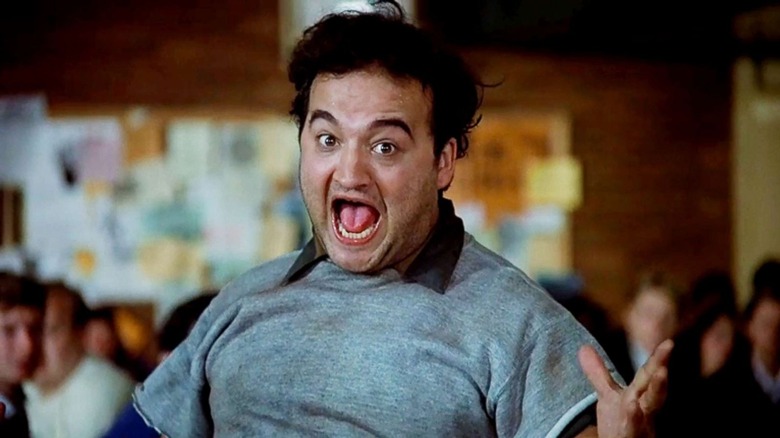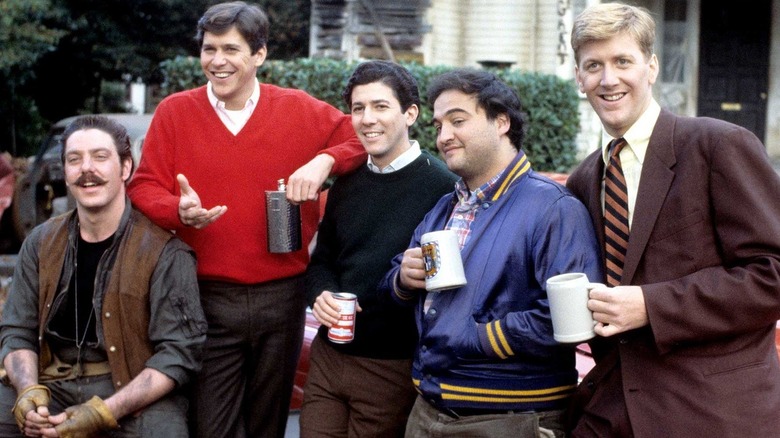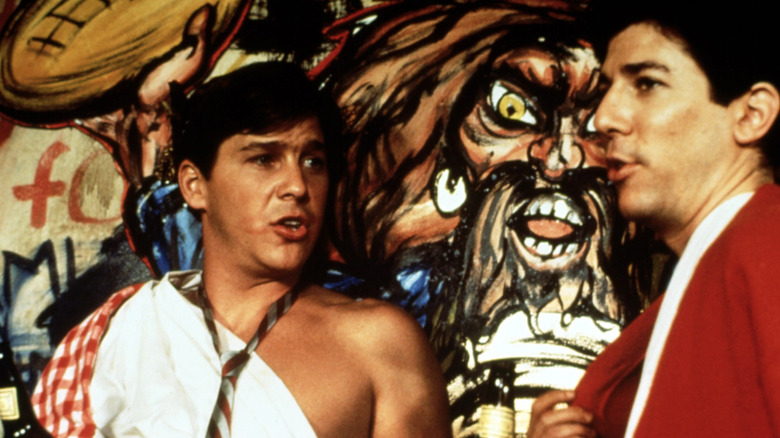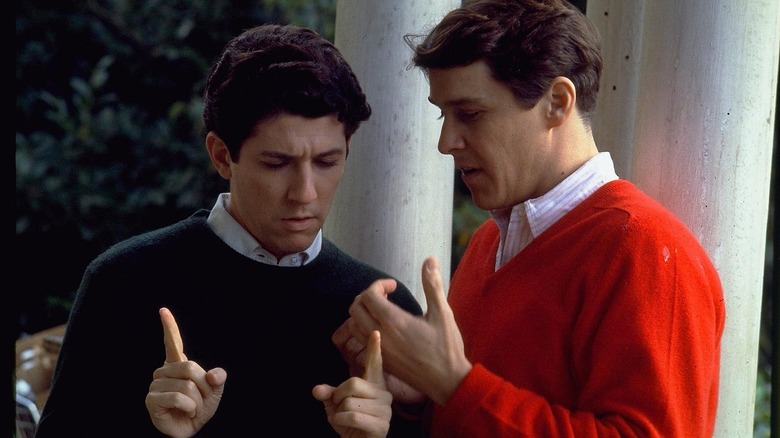Warner Bros. Was Convinced Animal House Could Never Be A Movie (And Wow, Were They Wrong)
Ah, 1978. It was the year that Slashfilm writer Lee Adams entered the world, and two movies changed the course of comedy forever (those landmarks are unrelated; I'm not trying to claim any credit). Those movies were "National Lampoon's Animal House" and Cheech and Chong's "Up in Smoke" — two lowbrow hits whose influences are still felt to this day.
There was lowbrow stuff before 1978, of course. Slapstick — the age-old art of falling over, breaking things, and hitting people — was still doing the rounds in the increasingly weary adventures of Inspector Clouseau. But the class of '78 was different: wild, irreverent, raucous, bawdy, subversive, counterculture comedy that delighted the kids and antagonized the squares.
The two films had their roots in the '60s. Cheech Marin and Tommy Chong developed their stand-up act in the latter part of the decade before making their break on the big screen with the granddaddy of stoner movies, without which we might not have "The Big Lebowski" or the "Harold and Kumar" franchise. Meanwhile, the creators of "Animal House" mainly went to college in the '60s, and used their experiences as the basis for a classic slob vs. snob teen comedy that set the table for everything from "Porky's" to "American Pie."
The influence of "Animal House" doesn't stop there. The film gave "Saturday Night Live" star John Belushi his first lead role as campus madman John "Bluto" Blutarsky, starting the trend of "SNL" alumni making a huge impact in big screen comedy vehicles. Steve Martin, Chevy Chase, Bill Murray, Dan Aykroyd, Eddie Murphy, and many others would follow. Come 1984, two SNL-led smash hits, "Ghostbusters" and "Beverly Hills Cop", dominated the box office both domestically and internationally.
So yeah, "Animal House" was a big deal for American cinema, but the bigwigs at Warner Bros. absolutely did not want to make the movie at all.
The origins of Animal House
"National Lampoon" magazine began in 1970, mostly run by young guys who were not long graduated from college, satirizing everything and anything in its distinctive anarchic style. In 1974, it published "National Lampoon: 1964 High School Year Book Parody," which served as something of a dry run for "Animal House." Although set only a decade earlier, it affectionately spoofed a time before the turbulent '60s really took off with sex, drugs, rock 'n' roll, protests, riots, the civil rights movement, high-profile assassinations such as Martin Luther King and Robert Kennedy, Woodstock, Altamont, and the peak of the Vietnam war. In other words, it was a totally different era.
"Animal House" was the team's first foray into film and, like "Year Book," it was also set a few years before the events that changed the country's psyche forever. That is perhaps why the movie mixes nostalgia for the early '60s and a knowing sense of irreverence stemming from a less innocent place after the tumultuous previous decade.
The idea for the movie itself came from out of the house. Ivan Reitman, who would later direct several films involving John Belushi's "SNL" co-stars, called up the magazine and proposed collaborating on a project. As a fan, he believed that "National Lampoon" in the title of a flick could make for good business. Their first step toward a big-screen venture was "The National Lampoon Show" on stage in New York with a cast including Bill Murray, John Belushi, Harold Ramis, Gilda Radner, and Brian Doyle-Murray, Bill's brother.
Next came the real thing. Harold Ramis teamed up with "Lampoon" staff Doug Kenney and Chris Miller to write a high school comedy initially called "Laser Orgy Girls," but worried that the age of the kids might get them in trouble. Instead, they delved into Miller's frat house stories from his college days and turned the concept into "Animal House."
Warner Bros. didn't get Animal House at all
In his book "Fat, Drunk, and Stupid: The Inside Story Behind the Making of Animal House," producer Matty Simmons, who took care of "National Lampoon's" business end, detailed his battle to get the movie to the screen. His first port of call was his lone contact in Hollywood, Steve Ross of Warners. Ross was initially enthusiastic about the prospect of a "National Lampoon" movie and asked Simmons to send over a treatment. So far, so good, but the project hit the buffers when Jay Emmett, the studio president, and Ted Ashley, head of the subsidiary Warner Bros., actually read the thing. Ross broke the bad news three days later:
"Jay just called from L.A. Ashley read the treatment last night and said it would never make a movie. Jay wanted him to reread it but Ashley was adamant about it. I'm his boss, Matty, but Ted's the movie expert and I don't want to go over his head."
With the movie a non-starter at Warners, the situation looked bleak. Simmons had no other contacts in Hollywood but didn't want to make "Animal House" a low-budget affair by resorting to Canadian investors.
"The 'Lampoon' was succeeding at everything we did. we had to do this right. No $80,000 budget. No Canadian distributor. We go big or we don't go at all."
You make your own luck, and Simmons' determination paid off when he received a surprise call from Jerry Miller; the assistant to Ned Tanen, president of Universal Pictures. Miller declared himself a fan of "National Lampoon" and expressed his interest if they ever decided to make a movie. As luck would have it, Simmons had the treatment all ready to go.
Animal House gets the green light ... just about
Presented with a new chance to get a major Hollywood studio on board for "Animal House," Matty Simmons wasn't leaving anything to chance. He insisted on flying to Los Angeles with Ivan Reitman to talk about the project with Ned Tanen before handing over the treatment. Tanen was less than enthusiastic about it, to say the least:
"I hate this treatment! Everybody is drunk, or high, or getting laid. I'd never make this movie — except you're the 'National Lampoon ...' Can you make it for three million?"
After they'd thrashed out a profit-sharing deal which meant Simmons and "National Lampoon" would receive 17.5% of everything over $20 million at the box office, they were good to go. Universal initially offered only 5%, and holding out for a higher percentage point was a masterstroke. Although the studio had agreed to finance "Animal House," they clearly underestimated its potential. From its modest budget of $3 million, the film raked in over $141 million at the box office, making it the highest-grossing comedy of all time until "Ghostbusters." Even Roger Ebert, who could sometimes get a little snobby about lowbrow comedies, gave it a maximum four-star rating and listed it among his best films of 1978. Warner Bros. must have been kicking themselves.
"Animal House" is a little dated now. On one hand, it is nowhere near as outrageous as some of the movies it opened the gate for; on the other, there are some scenes that are pretty iffy from a modern perspective. It still just about holds up thanks to the raucous performance of John Belushi, which cemented his status as the patron saint of the gross-out comedy.



